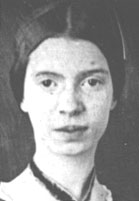Издателство |
| :. Издателство
LiterNet |
Медии |
| :. Електронно списание LiterNet |
| :. Електронно списание БЕЛ |
| :. Културни
новини |
Каталози |
| :. По
дати : Март |
| :. Електронни книги |
| :. Раздели / Рубрики |
| :. Автори |
| :. Критика за авторите |
Книжарници |
| :. Книжен
пазар |
| :. Книгосвят: сравни цени |
Ресурси |
| :. Каталог за култура |
| :. Артзона |
| :. Писмена реч |
За
нас |
| :. Всичко за LiterNet |
EMILY DICKINSON
(1830-1886)
 American lyrical poet, an obsessively private writer - only seven of her some
1800 poems were published during her lifetime, five of them in the Springfield
Republican. Dickinson withdrew from social contact at the age of 23 and devoted
herself in secret into writing.
American lyrical poet, an obsessively private writer - only seven of her some
1800 poems were published during her lifetime, five of them in the Springfield
Republican. Dickinson withdrew from social contact at the age of 23 and devoted
herself in secret into writing.
Emily Dickinson (1830-1886) was born in Amherst, Massachusetts, to a family well known for educational and political activity. Her father, an orthodox Calvinist, was a lawyer and treasurer of Amherst College, and also served in Congress. She was educated at Amherst Academy (1834-47) and Mount Holyoke Female Seminary (1847-48). Around 1850 Dickinson started to write poems, first in fairly conventional style, but after ten years of practice she began to give room for experiments. Often written in the metre of hymns, her poems dealt not only with issues of death, faith and immortality, but with nature, domesticity, and the power and limits of language in transferring the feelings of ecstasy and terror into written text. From c. 1858 she assembled many of her poems in packets of 'fascicles', which she bound herself with needle and thread. A selection of these poems appeared in 1890.
In 1862 Dickinson started her life long correspondence and friendship with writer Thomas Wentworth Higginson. On of the four poems he received from Dickinson was the famous 'Safe in their Alabaster Chambers.'
Although Higginson was astounded by her originality, he advised her not to publish, and encouraged otherwise her literary aspirations. Dickinson's decision to follow the advise was influenced by her ambivalent attitude toward the conventions of the nineteenth-century literary marketplace and her desire to shape more intimate relations with chosen contemporaries.
After the Civil War Dickinson restricted her contacts outside Amherst to exchange of letters, dressed only in white and saw few of the visitors who came to meet her. In fact, most of her time she spent in her room. Although she lived secluded life, her letters reveal knowledge of the writings of John Keats, John Ruskin, and Sir Thomas Browne. Dickinson's emotional life remains mysterious, despite much speculation about a possible disappointed love affair. Two candidates have been presented: Reverend Charles Wadsworth, with whom she corresponded, and Samuel Bowles, editor of the Springfield Republican, to whom she addressed many poems.
After Dickinson's death her poems were brought out by her sister Lavinia, who amazed at the bulk of Emily's poetry. She co-edited three volumes from 1891 to 1896. Despite its editorial imperfections, the first volume became popular. In the early decades of the twentieth century, Martha Dickinson Bianchi, the poet's niece, transcribed and published more poems, and in 1945 Bolts of Melody essentially completed the task of bringing Dickinson's poems to the public.
The publication of Thomas H. Johnson's edition of Emily Dickinson's poems finally gave readers a complete and accurate text. Johnson's work was not made easier that the author had left alternative versions of words, lines and sometimes of whole poems. Johnson found a valuable assistant in Theodora Ward, who was then completing an edition of Dickinson's letters to her grandparents.
Dickinson's works have had considerable influence on modern poetry. Her frequent use of dashes, sporadic capitalization of nouns, off-rhymes, broken metre, unconventional metaphors have contributed her reputation as one of the most innovative poets of 19th-century American literature.
Later feminist critic have challenged the popular conception of the poet as reclusive, eccentric figure, and underlined her intellectual and artistic sophistication. Dickinson's imagery reflects an intense and painful struggle over many years, her verse is full of allusions to volcanoes, shipwrecks, funerals, and other manifestations of natural and human violence, which she hide into her writings. Pain and extreme psychic feelings were among her central themes. Pain widens the sense of time, it swallows the self, creates its own sense of eternity. She wrote to Higginson, "I had a terror - since September - I could tell to none - and so I sing as the Boy does by the Burying Ground - because I am afraid."
Scholars have explored Dickinson's relationship with her sister-in-law, Sue Gilbert, her admiration for the English poet Elisabeth Barrett Browning's (1806-1861) work and her affection for US writer Helen Hunt Jackson (1830-1885). Dickinson read poetry voraciously and called poets "the dearest ones of time, the strongest friends of soul." Judith Farr have pointed out that she spoke of the soul or souls 141 times in her poems. Soul was for her a lost boat, an internal lamp, a storm within, an emperor. "The Soul unto itself / Is an imperial friend - / Or the most agonizing Spy / An Enemy - could send - "
=============================
© E-publisher LiterNet, 03.05.2009
The Sun Is but a Morning Star. Anthology of American Literature. Edited by Albena
Bakratcheva. Varna: LiterNet, 2008-2010.
